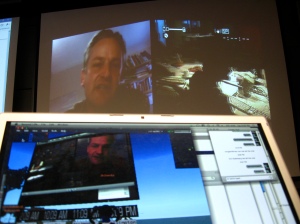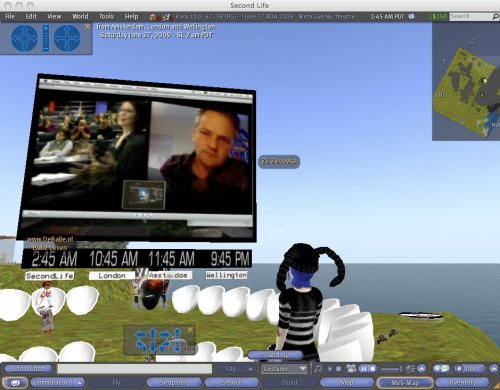
A response to Saturday nights networked discussion featuring Matthew Fuller in London, Eric Kluitenburg in Amsterdam, with Sue Ballard & Symposium delegats in Wellington, 27 / 6 / 09.
At the outset of his thoughts on digital and materiality, Matthew launched the topic with some thoughts on ‘immateriality’ as a way of approaching the material, – a proposition of opposites that got the discourse away, to my mind, on a somewhat confused metaphysical tack. Eric in Amsterdam responded, with various references and abstractions including a definition of materiality, from Latin/French roots, ie; mater = mother, riality = reality, materiality = the mother of reality; a meaning suggesting matter as something substantial and solid. A meaning on the surface that appears to make sense relative to its opposite, immateriality.
If we accept the premise then, firstly, that all matter is essentially vibration – a deduction of physical science and a long-held esoteric belief in relation to life in this solar system; and secondly, that the body, as Eric pointed out, reproduces itself regularly on a cellular level – replicating cells each time with such fractional difference as to account over time for the ageing process of all living things – then this knowledge surely joins us to the universal ephemeral principle, that every living thing inexorably proceeds as a process of change, towards it’s moment of death and decay.
If we accept this understanding, materiality and immateriality, along with a host of other polarities, fall under the planetary law of opposites, where one is inextricably entwined with the other ; life/death, creation/destruction, visible/invisible, dark/light, on/off, and so forth. This is the fabric of life in the third and fourth dimensions as we know it – ensnared between pairs of opposites, caught in the dualistic web so aptly described as ‘veils of illusion, MAYA’ by Buddhist and Vedic ancients – and so potently portrayed in Plato’s cave parable, as ephemeral, transient reality, a view far removed, and to my mind truer than the ‘mother-of-reality’ idea that matter is solid and real.
How then to bridge this with the ADA theme of digital and materiality – one abstract and ephemeral, the other grounded in physical material – so it develops constructively?
The binary digital world is composed of zeros and ones. Zero, an expression of nought = nothingness, and one, an expression of 1 = unity. Nought and one, continuing the above line of discussion, imply ephemeral and permanent, nothingness and being, but if we think of these as complimentaries brought into a synergistic relationship, then we are engaged with the triadic rather than the dualistic.
Marrying the seemingly disparate opposites of material and immaterial, physical and digital in a synergistic relationship – active, passive and reconciling, enables transmutation and evolution. This law of three, the same ancient principle re-interpreted by Hegel as the dialectic – (thesis – the active proposition, antithesis – the negative opposing view, and synthesis – the reconciling force to create a new result) – animates an exchange between opposites, and provides the condition for creative development. This is the same tessellating design principle that exploits the equilateral triangle so beautifully in Islamic design. A dynamic principle to energise and catalyse situations, concepts, technologies, collaborations etc, etc with. And with unique results.
This was elegantly demonstrated in Julian Priest’s conceptually evocative beachfire and digital output piece, where heat, generated by the fire on the beach triggered a wireless connection to the internet to switch the zero = absence of heat, to digit one = presence of heat; a poetic metaphor for bridging opposite states of immaterial / material, invisible / visible, nothingness and being, darkness and light.
Reading the zero as a circle, and the one as one, gives to both the power of unity, a marriage of opposites. Bravo !
Phil Dadson
1/7/09
Filed under: Uncategorized | Leave a Comment
Phil Dadson: Digital Resonances
Gentle and unassuming, Phil’s presentation began with a tale from the Upanishads of a man, his son, some water and some salt. That physical substance which dissolves into transparency yet can be tasted in everything it touches. As analogous to a principle of the physical essence of being, it demonstrates that often strangely ephemeral sense we can tend to have of ourselves. This and other concepts of immateriality, apparent or otherwise, would echo through later discussions and questions – always haunted in some way by the question of how we see ourselves in the so-called ‘virtual’ and ‘physical’ worlds.
Filed under: Uncategorized | 1 Comment
Short Presentations – 01w
Peter Gorman – Toward a Mind Controlled Strange Attractor
Morgan Barnard – Improvisation as a methodology for content creation in Live Cinema
Emil McAvoy – A New Mediation of New Zealand Government Photography
Max Bellamy – Microcosms
Stella Brennan and Zita Joyce – Cloudland
Laura Preston – The Future is Unwritten exhibition as proposition
Tim Coster – Beyond digital processing and distribution
WARNING: THIS IS YET TO UNDERGO EDITING & TIDYING (!)…
Filed under: Uncategorized | 1 Comment
A Reflection on Quartz Composer
Today I managed to join up with the Urban Screens workshop, run by Morgan Barnard. I was running around before hand, so I missed the intro, although I am sure it went peachy.
The intro I did gather was all about Quartz. So for this little post I plan to recap the topics covered, hopefully provide a rough step-by-step. I suppose this is to stand as a small review and a reference for those who wish to recall some Quartz basics.
Filed under: Uncategorized | Leave a Comment
ADA Symposium Film Screening

8pm Film Screening, curated by Alex MacKinnon
Thistle Hall, cnr Cuba and Arthur Streets
Filed under: Uncategorized | Leave a Comment
Tags: #ada2009



